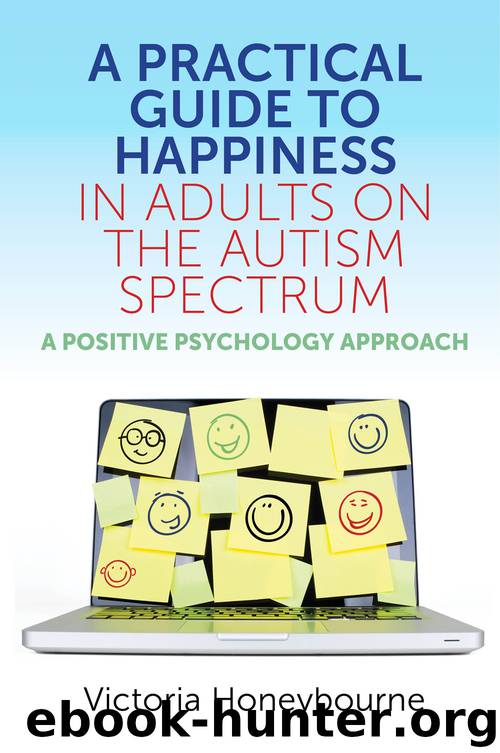A Practical Guide to Happiness in Adults on the Autism Spectrum by Victoria Honeybourne

Author:Victoria Honeybourne
Language: eng
Format: epub
ISBN: 9781784509880
Publisher: Jessica Kingsley Publishers
Published: 2018-12-20T16:00:00+00:00
OPTIMIST VERSUS PESSIMIST
Aim: To understand the difference between optimism and pessimism.
How to do it: This activity can be delivered by splitting the main group into two (one group to take on the role of ‘optimists’ and the other of ‘pessimists’), or by asking the group to work in pairs, with one person taking on the role of ‘optimist’ and the other of ‘pessimist’.
1. Give out one set of the cards provided in Appendix E to each pair. If delivering this activity in a whole group situation, simply read the cards aloud, one at a time.
2. Ask the designated ‘optimists’ to think of an optimistic response to that situation, and the designated ‘pessimists’ to consider a pessimistic response. (There are no ‘right’ or ‘wrong’ answers as such, and various suggestions might be made. The main aim is to support an understanding of ‘optimism’ and ‘pessimism’.)
3. You might like to switch the groups halfway through to give all participants the opportunity to practise both optimistic and pessimistic thinking. Example:
Situation card (from Appendix E): You have made some new friends at a sports club you go to and wonder if they would like to go for coffee and cake one day after training.
Possible optimistic thought: ‘I can make the suggestion. Some might be busy or not able to make it, but others might like to come.’
Possible pessimistic thought: ‘Nobody will want to socialise with me and they will all say “no”. I won’t bother asking them.’
4. You might like to ask participants if they feel they have a tendency for one way of thinking. Can anybody share examples?
5. To develop this activity, discuss the possible consequences of both extremes. Choose some of the situations and discuss what an extreme pessimistic response might lead to, and then an extreme optimistic response. Explain to the group that being too pessimistic might lead to you avoiding situations and fearing the worst, while being too optimistic might mean that you fail to prepare adequately for some situations. A better response is that of ‘realistic optimism’, being optimistic but planning realistically.
Download
This site does not store any files on its server. We only index and link to content provided by other sites. Please contact the content providers to delete copyright contents if any and email us, we'll remove relevant links or contents immediately.
I Capture the Castle by Dodie Smith(1905)
Aspergirls by Rudy Simone(1585)
Be Different by John Elder Robison(1558)
Autism's False Prophets by Paul A. Offit(1450)
My Child's Different by Elaine Halligan(1428)
Smart but Scattered—and Stalled by Richard Guare(1414)
101 Tips for the Parents of Boys with Autism by Ken Siri(1382)
What's Making Our Children Sick? by Michelle Perro(1350)
Asperger Syndrome (Autism Spectrum Disorder) and Long-Term Relationships by Ashley Stanford(1331)
ADHD by Mark Selikowitz(1304)
Girlish by Lara Lillibridge(1294)
Nerdy, Shy, and Socially Inappropriate by Cynthia Kim(1272)
An Adult with an Autism Diagnosis by Gillan Drew(1265)
On Immunity: An Inoculation by Biss Eula(1245)
Animal-assisted Interventions for Individuals with Autism by Temple Grandin(1223)
Sarah's Child (Hqn Romance) by Linda Howard(1221)
Seeing Ezra by Kerry Cohen(1199)
Why Gender Matters by Leonard Sax M.D. Ph.D(1184)
The Cities by K.A Knight(1178)
